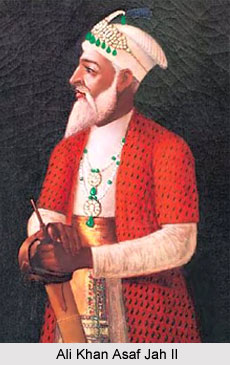 Ali Khan Asaf Jah II, also known Nawab Mir Nizam Ali Khan Siddiqi Bahadur Asaf Jah II, was the ruler or Nizam of the princely state of Hyderabad in Southern India. From 1798, Hyderabad became a princely state that existed along with the British East India Company. He ruled over the territory from the year 1762 to 1803. Ali Khan Asaf Jah II was born on 7th March 1734 to Mir Qamar-ud-din Khan Siddiqi Asaf Jah I and his wife Umda Begum, as their fourth son. The official title and name of Asaf Jah II was Asaf Jah II, Nizam ul-Mulk, Nizam ud-Daula, Nawab Mir Nizam Ali Khan Siddiqi Bahadur, Fath Jang, Sipah Salar, Nawab Subedar of the Deccan.
Ali Khan Asaf Jah II, also known Nawab Mir Nizam Ali Khan Siddiqi Bahadur Asaf Jah II, was the ruler or Nizam of the princely state of Hyderabad in Southern India. From 1798, Hyderabad became a princely state that existed along with the British East India Company. He ruled over the territory from the year 1762 to 1803. Ali Khan Asaf Jah II was born on 7th March 1734 to Mir Qamar-ud-din Khan Siddiqi Asaf Jah I and his wife Umda Begum, as their fourth son. The official title and name of Asaf Jah II was Asaf Jah II, Nizam ul-Mulk, Nizam ud-Daula, Nawab Mir Nizam Ali Khan Siddiqi Bahadur, Fath Jang, Sipah Salar, Nawab Subedar of the Deccan.
Rule of Ali Khan Asaf Jah II
In the year 1759, Nizam Nawab Mir Nizam Ali Khan Siddiqi Bahadur Asaf Jah II became the administrator and chief commander of the Deccan. He earned much reputation as an accomplished commander due to his victorious methods of combating against the Marathas. During the year 1761, when the Marathas retreated from the 3rd Battle of Panipat, Nizam Ali Khan Asaf Jah II, along with his strong army, revolted and advanced the Maratha forces to Pune and forcefully prosecuted Balaji Rao in order to sustain peace. He later seized the Bidar Fort and then detained Salabat Jung.
Shah Alam II, the Mughal Emperor, sanctioned this action of the Nizam of the princely state of Hyderabad. As a result of this, Salabat Jung was terminated from his position as the Subedar of Deccan after Shah Alam II issued a Firman. Later Nizam Ali Khan Asaf Jah II was appointed as the new Subedar of Deccan on 8th July 1762. Later in 1763, he shifted his capital to Hyderabad from Aurangabad. Raghunath Rao, the Peshwa of the Maratha Confederacy, allied with the Nizam of Hyderabad in the year 1762, due to mutual mistrust and disparity with Madhavrao Peshwa. The Nizam Asaf Jah II marched towards Pune. During the year 1763, Madhavrao Peshwa defeated Nawab Mir Nizam Ali Khan Siddiqi Bahadur Asaf Jah II at Rakshabhuvan and compelled him to sign a treaty with the Maratha rulers.
After he was defeated by the Marathas in 1795, Asaf Jah II ceded Sholapur, Aurangabad and Daulatabad. Soon afterwards, he entered into Subsidiary Alliance with the British East India Company. Eventually the state of Hyderabad became a one of the major princely states in the country under the British indirect rule.
Ali Khan Asaf Jah II, the Nizam of the princely state of Hyderabad died at the age of 69 on 6th August 1803 at Chowmahalla, Hyderabad.



















